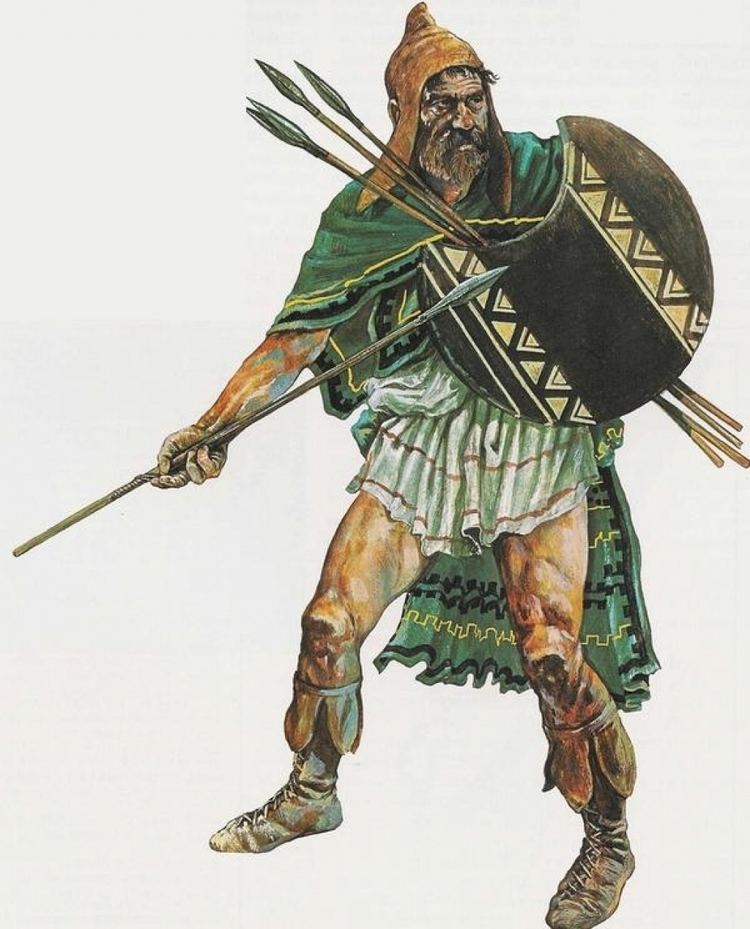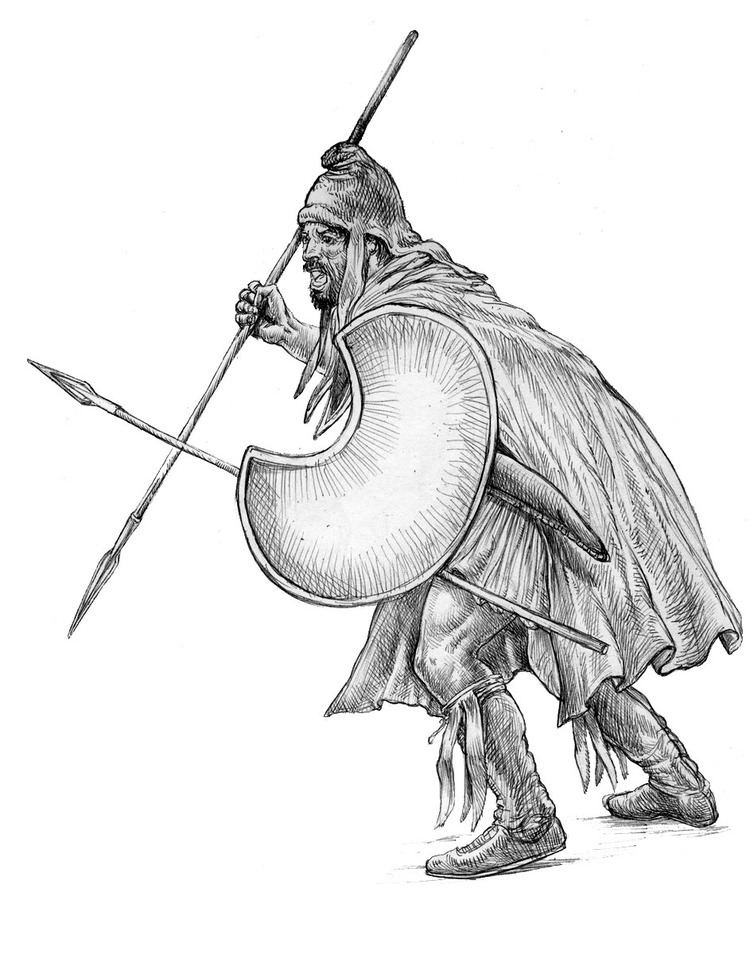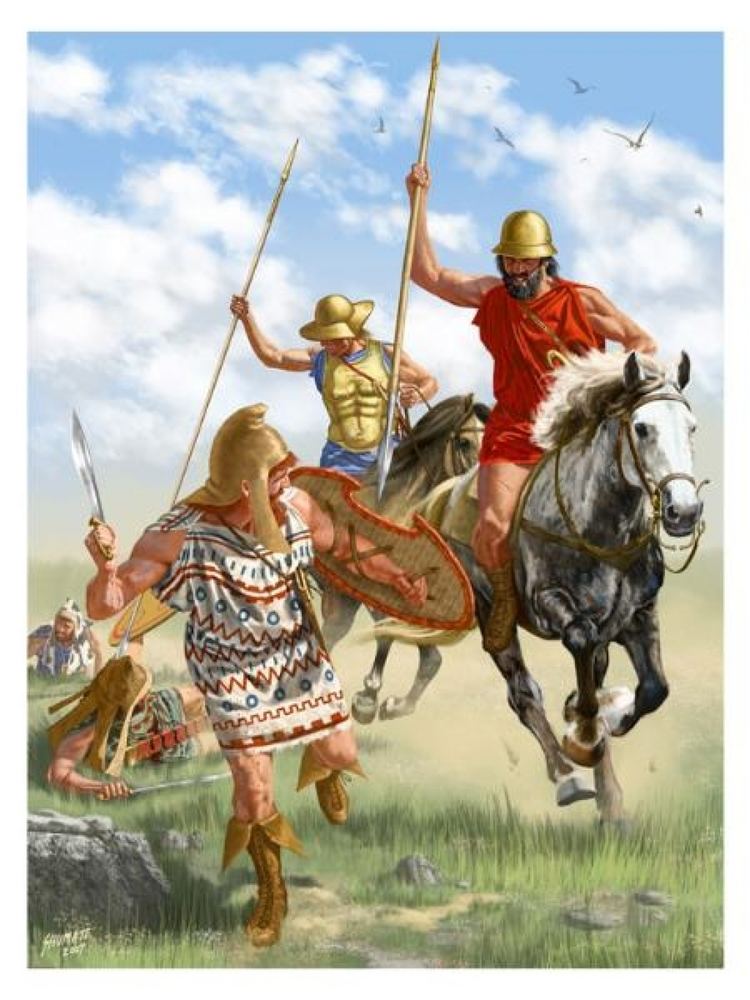 | ||
Similar Dacians, Getae, Illyrians | ||
The thracians a hidden history hd 2013
The Thracians (/ˈθreɪʃənz/; Ancient Greek: Θρᾷκες Thrāikes, Latin: Thraci) were a group of Indo-European tribes inhabiting a large area in southeastern Europe. They spoke the Thracian language – a scarcely attested branch of the Indo-European language family. The study of Thracians and Thracian culture is known as Thracology. Thracians are one of the three primary ancestral groups of modern Bulgarians.
Contents
- The thracians a hidden history hd 2013
- Our ancestors thracians
- Etymology
- Mythological foundation
- Origins and ethnogenesis
- Identity and distribution
- Archaic period
- Classical period
- Roman rule
- War
- Barbarians
- Religion
- Physical appearance
- After Christianization
- Famous individuals
- Archaeology and treasures
- References

Our ancestors thracians
Etymology

The first historical record about the Thracians is found in the Iliad, where they are described as allies of the Trojans in the Trojan War against the Greeks. The ethnonym Thracian comes from Ancient Greek Θρᾷξ (plural Θρᾷκες; Thrāix, Thrāikes) or Θρᾴκιος/Ionic: Θρηίκιος (Thrāikios/Thrēikios), and the toponym Thrace comes from Θρᾴκη/Ion.: Θρῄκη (Thrāikē/Thrēikē). These forms are all exonyms as applied by the Greeks.
Mythological foundation

In Greek mythology, Thrax (by his name simply the quintessential Thracian) was regarded as one of the reputed sons of the god Ares. In the Alcestis, Euripides mentions that one of the names of Ares himself was "Thrax" since he was regarded as the patron of Thrace (his golden or gilded shield was kept in his temple at Bistonia in Thrace).
Origins and ethnogenesis

The origins of the Thracians remain obscure, in the absence of written historical records. Evidence of proto-Thracians in the prehistoric period depends on artifacts of material culture. Leo Klejn identifies proto-Thracians with the multi-cordoned ware culture that was pushed away from Ukraine by the advancing timber grave culture. It is generally proposed that a proto-Thracian people developed from a mixture of indigenous peoples and Indo-Europeans from the time of Proto-Indo-European expansion in the Early Bronze Age when the latter, around 1500 BC, mixed with indigenous peoples. We speak of proto-Thracians from which during the Iron Age (about 1000 BC) Dacians and Thracians begin developing.
Identity and distribution

Divided into separate tribes, the Thracians did not manage to form a lasting political organization until the Odrysian state was founded in the fifth century BC. A strong Dacian state appeared in the first century BC, during the reign of King Burebista. Including the Illyrians, the mountainous regions were home to various peoples regarded as warlike and ferocious Thracian tribes, while the plains peoples were apparently regarded as more peaceable.

Thracians inhabited parts of the ancient provinces of Thrace, Moesia, Macedonia, Dacia, Scythia Minor, Sarmatia, Bithynia, Mysia, Pannonia, and other regions of the Balkans and Anatolia. This area extended over most of the Balkans region, and the Getae north of the Danube as far as beyond the Bug and including Panonia in the west. There were about 200 Thracian tribes
Archaic period
These Indo-European peoples, while considered barbaric and rural by their urbanized Greek neighbors, had developed advanced forms of music, poetry, industry, and artistic crafts. Aligning themselves in kingdoms and tribes, they never displayed any form of national unity beyond short, dynastic rules at the height of the Greek classical period. Similar to the Celtic (e.g., Gauls) and Slavic tribes, most people are thought to have lived simply in small fortified villages, usually on hilltops.
Although the concept of an urban center was not developed until the Roman period, various larger fortifications which also served as regional market centers were numerous. Yet, in general, despite Greek colonization in such areas as Byzantium, Apollonia and other cities, the Thracians avoided urban life.
The first Greek colonies in Thrace were founded in the eighth century BC.
Thrace south of the Danube (except for the land of the Bessi) was ruled for nearly half a century by the Persians under Darius the Great, who conducted an expedition into the region from 513 to 512 BC. The Persians called Thrace "Skudra".
Classical period
In the first decade of the sixth century BC, the Persians invaded Thrace and made it part of their satrapy Skudra. Thracians were forced to join the invasions of European Scythia and Greece. According to Herodotus, the Bithynian Thracians also had to contribute a large contingent to Xerxes' invasion of Greece in 480 BC. Subjugation of Macedonia was part of Persian military operations initiated by Darius the Great (521-486) in 513 - after immense preparations - a huge Achaemenid army invaded the Balkans and tried to defeat the European Scythians roaming to the north of the Danube River. Darius' army subjugated several Thracian peoples at the same time, and virtually all other regions that touch the European part of the Black Sea, such as parts currently of Bulgaria, Romania, Ukraine, and Russia, before it returned to Asia Minor. Darius left in Europe one of his commanders named Megabazus whose task was to accomplish conquests in the Balkans. The Persian troops subjugated gold-rich Thrace, the coastal Greek cities, as well as defeating and conquering the powerful Paeonians. Finally, Megabazus sent envoys to Amyntas, King of Macedon demanding acceptation of Persian domination, which the Macedonian accepted. At this time, many if not most Thracians fell under Persian rule.
By the fifth century BC, the Thracian presence was pervasive enough that Herodotus called them the second-most numerous people in the part of the world known by him (after the Indians), and potentially the most powerful, if not for their lack of unity. The Thracians in classical times were broken up into a large number of groups and tribes, though a number of powerful Thracian states were organized, such as the Odrysian kingdom of Thrace and the Dacian kingdom of Burebista. The peltast, a type of soldier of this period, probably originated in Thrace.
During this period, a subculture of celibate ascetics called the "ctistae" lived in Thrace, where they served as philosophers, priests and prophets.
In that period, contacts between the Thracians and Classical Greece intensified.
Before the expansion of the Kingdom of Macedon, Thrace was divided into three camps (east, central, and west) after the withdrawal of the Persians from Europe. A notable ruler of the East Thracians was Cersobleptes, who attempted to expand his authority over many of the Thracian tribes. He was eventually defeated by the Macedonians.
Thracian civilisation was not urban and the largest Thracian cities may have been in fact large villages. The Thracians were typically not city-builders and their only polis was Seuthopolis.
The conquest of the southern part of Thrace by Philip II of Macedon in the fourth century BC made the Odrysian kingdom extinct for several years. After the kingdom had been reestablished, it was a vassal state of Macedon for several decades under generals such as Lysimachus of the Diadochi.
In 279 BC, Celtic Gauls advanced into Macedonia, southern Greece and Thrace. They were soon forced out of Macedonia and southern Greece, but they remained in Thrace until the end of the third century BC. From Thrace, three Celtic tribes advanced into Anatolia and formed a new kingdom called "Galatia".
In parts of Moesia (northeast Serbia) the Celtic Scordisci and Thracians lived beside each other, evident in the archaeological findings of pits and treasures, spanning from the third century BC to the first century BC.
During the Macedonian Wars, conflict between Rome and Thracia was unavoidable. The ruling parties in Macedonia weakened and Thracian tribal authority resurged. But after the Battle of Pydna in 168 BC, Roman authority over Macedonia seemed inevitable, and the governing of Thracia passed to Rome.
Initially, Thracians and Macedonians revolted against Roman rule. For example, the revolt of Andriscus in 149 BC, drew the bulk of its support from Thracia. Several incursions by local tribes into Macedonia continued for many years, though a few tribes willingly allied with Rome, such as the Deneletae and the Bessi.
After the Third Macedonian War, Thracia acknowledged Roman authority. The client state of Thracia comprised several tribes.
Roman rule
The next century and a half saw the slow development of Thracia into a permanent Roman client state. The Sapaei tribe came to the forefront initially under the rule of Rhascuporis. He was known to have granted assistance to both Pompey and Caesar, and later supported the Republican armies against Antonius and Octavian in the final days of the Republic.
The familiar heirs of Rhascuporis were then as deeply tied into political scandal and murder as were their Roman masters. A series of royal assassinations altered the ruling landscape for several years in the early Roman imperial period. Various factions took control, with the support of the Roman Emperor. The turmoil would eventually stop with one final assassination.
After Rhoemetalces III of the Thracian Kingdom of Sapes was murdered in AD 46 by his wife, Thracia was incorporated as an official Roman province to be governed by Procurators, and later Praetorian prefects. The central governing authority of Rome was based in Perinthus, but regions within the province were uniquely under the command of military subordinates to the governor. The lack of large urban centers made Thracia a difficult place to manage, but eventually the province flourished under Roman rule. However, Romanization was not attempted in the province of Thracia. The Balkan Sprachbund does not support hellenization.
Roman authority of Thracia rested mainly with the legions stationed in Moesia. The rural nature of Thracia's populations, and distance from Roman authority, certainly inspired the presence of local troops to support Moesia's legions. Over the next few centuries, the province was periodically and increasingly attacked by migrating Germanic tribes. The reign of Justinian saw the construction of over 100 legionary fortresses to supplement the defense.
Thracians in Moesia were Romanized while those in Thrace and surrounding areas would come to be known as the Bessi. In 6th century AD the Bessian (i.e. Thracian) language was reportedly still in use by monks in a Mount Sinai monastery.
War
The history of Thracian warfare spans from c. 10th century BC up to the 1st century AD in the region defined by Ancient Greek and Latin historians as Thrace. It concerns the armed conflicts of the Thracian tribes and their kingdoms in the Balkans and in the Dacian territories. Emperor Traianus conquered Dacia after two wars in the 2nd century AD. The wars finished with the occupation of the fortress of Sarmisegetusa and the death of the king Decebalus. Apart from conflicts between Thracians and neighboring nations and tribes, numerous wars were recorded among Thracian tribes too.
Barbarians
Thracians were regarded by other people as warlike, ferocious, and bloodthirsty. They were seen as "barbarians" by ancient Greeks and Romans. Plato in his Republic considers them, along with the Scythians, extravagant and high spirited and his Laws considers them war-like nations grouping them with Celts, Persians, Scythians, Iberians and Carthaginians. Polybius wrote of Cotys's sober and gentle character being unlike that of most Thracians. Tacitus in his Annals writes of them being wild, savage and impatient, disobedient even to their own kings.
Polyaenus and Strabo write how the Thracians broke their pacts of truce with trickery. The Thracians struck their weapons against each other before battle, in the Thracian manner, as Polyaneus testifies. Diegylis was considered one of the most bloodthirsty chieftains by Diodorus Siculus. An Athenian club for lawless youths was named after the Triballi.
According to ancient Roman sources, the Dii were responsible for the worst atrocities of the Peloponnesian War killing every living thing, including children and the dogs in Tanagra and Mycalessos. Thracians would impale Roman heads on their spears and rhomphaias such as in the Kallinikos skirmish at 171 BC. Herodotus writes that "they sell their children and let their maidens commerce with whatever men they please".
Religion
One notable cult that is attested from Thrace to Moesia and Scythia Minor is that of the "Thracian horseman", also known as the "Thracian Heros", at Odessos (Varna) attested by a Thracian name as Heros Karabazmos, a god of the underworld usually depicted on funeral statues as a horseman slaying a beast with a spear. Dacians had a monotheistic religion based on the god Zalmoxis. The supreme Baltic thunder god Perkon was part of the Thracian pantheon, although cults to Orpheus and Zalmoxis likely surpassed him.
Some think that the Greek god Dionysus evolved from the Thracian god Sabazios.
Physical appearance
Several Thracian graves or tombstones have the name Rufus inscribed on them, meaning "redhead" – a common name given to people with red hair. Ancient Greek artwork often depicts Thracians as redheads. Rhesus of Thrace, a mythological Thracian King, derived his name because of his red hair and is depicted on Greek pottery as having red hair and beard. Ancient Greek writers also described the Thracians as red haired. A fragment by the Greek poet Xenophanes describes the Thracians as blue-eyed and red haired:
...Men make gods in their own image; those of the Ethiopians are black and snub-nosed, those of the Thracians have blue eyes and red hair.
Bacchylides described Theseus as wearing a hat with red hair, which classicists believe was Thracian in origin. Other ancient writers who described the hair of the Thracians as red include Hecataeus of Miletus, Galen, Clement of Alexandria, and Julius Firmicus Maternus.
Nevertheless, academic studies have concluded that peoples had different physical features than the described by primary sources. Ancient authors described as red-haired varieties of peoples, they claimed that all Slavs had red-hair, likewise described the Scythians, which is diminished as incorrect. According to Dr. Beth Cohen, Thracians had "the same dark hair and the same facial features as the Ancient Greeks." Recent genetic analysis comparing mtDNA samples of ancient Thracian fossil material from southeastern Romania with individuals from modern ethnicities place Italian (7.9%), the Albanian (6.3%) and the Greek (5.8%) have shown a bias of closer genetic kinship with the Thracian individuals than the Romanian and Bulgarian individuals (4.2%), but it was noted that more mtDNA sequences from Thracian individuals are needed in order to perform a complex objective statistical analysis. On the other hand, Dr. Aris N. Poulianos states that Thracians, like modern Bulgarians, belong mainly to the Aegean anthropological type.
After Christianization
See also Dacian language, Thracian language.The ancient languages of these people and their cultural influence were highly reduced due to the repeated barbaric invasions of the Balkans by Celts, Huns, Goths, Scythians, Sarmatians and Slavs, accompanied by, romanization and later slavicisation. However, the Thracians as a group did not entirely disappear, with the Bessi surviving at least until the late 4th century. Towards the end of the 4th century, Nicetas the Bishop of Remesiana brought the gospel to "those mountain wolves", the Bessi. Reportedly his mission was successful, and the worship of Dionysus and other Thracian gods was eventually replaced by Christianity. In 570, Antoninus Placentius said that in the valleys of Mount Sinai there was a monastery in which the monks spoke Greek, Latin, Syriac, Egyptian and Bessian. The origin of the monasteries is explained in a mediaeval hagiography written by Simeon Metaphrastes, in Vita Sancti Theodosii Coenobiarchae in which he wrote that Theodosius the Cenobiarch founded on the shore of the Dead Sea a monastery with four churches, in each being spoken a different language, among which Bessian was found. The place where the monasteries were founded was called "Cutila", which may be a Thracian name. The further fate of the Thracians is a matter of dispute. Some authors like Schramm derived the Albanians from the Christian Bessi, or Bessians, an early Thracian people who were pushed westwards into Albania, while more mainstream historians support Illyrian-Albanian continuity or a possible Thraco-Illyrian creole.
Famous individuals
This is a list of historically important personalities being entirely or partly of Thracian ancestry:
Archaeology and treasures
The branch of science that studies the ancient Thracians and Thrace is called Thracology. Archaeological exploration into Thracian culture began in the 20th century, with significant advancements made post-World War II, predominantly within southern Bulgaria. Intensive excavation efforts during the 1960s and 1970s led to the discovery of numerous Thracian tombs and sanctuaries. Among the most notable findings are the Tomb of Sveshtari, the Tomb of Kazanlak, Tatul, Seuthopolis, Perperikon, the Tomb of Aleksandrovo, and Sarmizegetusa in Romania, among others.
Also a large number of elaborately crafted gold and silver treasure sets from the 5th and 4th century BC were unearthed. In the following decades, those were exposed in museums around the world, thus gaining popularity and becoming an emblem of the ancient Thracian culture. Since the year 2000, Bulgarian archaeologist Georgi Kitov has made discoveries in Central Bulgaria which were summarized as "The Valley of the Thracian Kings". The residence of the Odrysian kings was found in Starosel in the Sredna Gora mountains. In Bulgaria there are 6,269- 10,000 necropolises.
